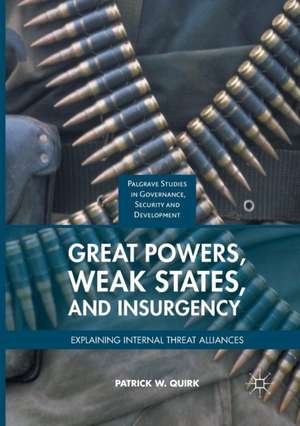Great Powers, Weak States, and Insurgency: Explaining Internal Threat Alliances: Governance, Security and Development
Autor Patrick W. Quirken Limba Engleză Paperback – 3 mai 2018
Preț: 193.97 lei
Nou
Puncte Express: 291
Preț estimativ în valută:
37.12€ • 38.89$ • 30.68£
37.12€ • 38.89$ • 30.68£
Carte disponibilă
Livrare economică 21 martie-04 aprilie
Preluare comenzi: 021 569.72.76
Specificații
ISBN-13: 9783319837321
ISBN-10: 331983732X
Pagini: 278
Ilustrații: XI, 278 p.
Dimensiuni: 148 x 210 x 19 mm
Greutate: 0.35 kg
Ediția:Softcover reprint of the original 1st ed. 2017
Editura: Springer International Publishing
Colecția Palgrave Macmillan
Seria Governance, Security and Development
Locul publicării:Cham, Switzerland
ISBN-10: 331983732X
Pagini: 278
Ilustrații: XI, 278 p.
Dimensiuni: 148 x 210 x 19 mm
Greutate: 0.35 kg
Ediția:Softcover reprint of the original 1st ed. 2017
Editura: Springer International Publishing
Colecția Palgrave Macmillan
Seria Governance, Security and Development
Locul publicării:Cham, Switzerland
Cuprins
1. Internal Threat Alliances: A New Conceptual Framework .- 2. U.S.-Colombia Internal Threat Alliance (1980-2010) .- 3. U.S.-Afghanistan Internal Threat Alliance (2001-2012) .- 4. Russia-Syria Internal Threat Alliance (2010-2016) .- 5. Conclusions.
Notă biografică
Patrick W. Quirk is a Senior Policy Advisor with the Bureau of Conflict and Stabilization Operations at the US Department of State and an Adjunct Professor in the Department of Government at Georgetown University, USA.
Textul de pe ultima copertă
This book offers an original and theoretically rich examination into the dynamics of alliances that great powers and weak states form to defeat threats, such as rebellion or insurgency, within the smaller state’s borders. The author analyzes contemporary examples of such “internal threat alliances,” including Russia’s collaboration with Syria’s Assad regime to defeat anti-government rebels and US cooperation with Colombia’s government to defeat leftist insurgents. In each case, the weaker state’s leadership wanted to remain in power while the great power sought to safeguard its interests linked to the regime’s stability. The book adds to International Relations theory by presenting a distinct conceptual framework that explains why internal threat alliances form, why some are more cohesive than others, and why some are effective while others are not. It thus promises to be of interest to IR scholars and students working in the areas of security studies, alliance dynamics, political violence, and civil war, but also to policy-makers grappling with how to salvage interests, such as access to natural resources or regional stability, imperilled by violence in weak states.
Caracteristici
Covers a blind spot in IR theory by focusing on the increasing threat that intra-state violence poses to weak states and great powers alike Offers detailed and politically relevant case studies, including U.S collaboration with Afghanistan and Colombia as well as Russia's involvement with Syria's Assad regime Speaks to policy-makers and national security professionals by offering an accessible framework for understanding and predicting state responses to internal threats












